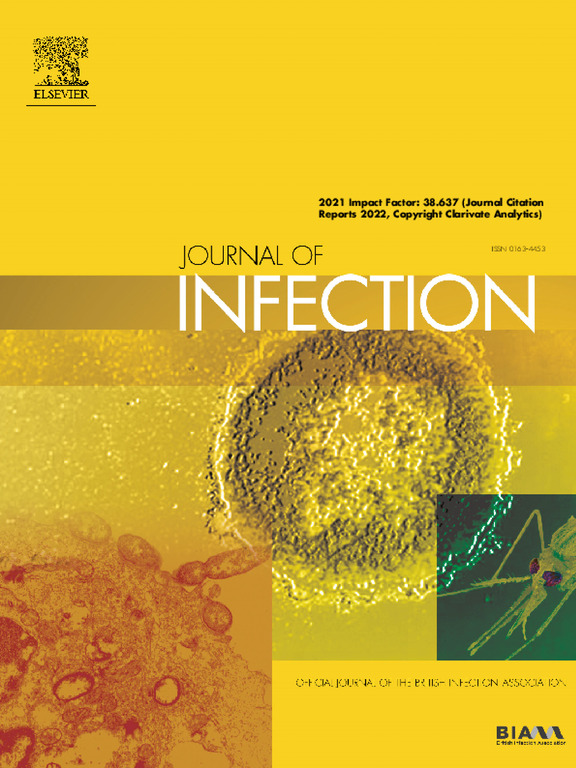钩端螺旋体病所致严重肺出血性综合征的MicroRNA生物标志物和宿主反应途径:一项多组学研究。
IF 14.3
1区 医学
Q1 INFECTIOUS DISEASES
引用次数: 0
摘要
背景:重度肺出血性综合征(SPHS)仍然是钩端螺旋体病的致命并发症,其机制尚不清楚,迫切需要有效的生物标志物。方法:采用巢式病例-对照分析方法,对先前两个泰国钩端螺旋体病队列的血液标本进行分析。候选microrna最初是通过对5例SPHS和7例非SPHS患者的798种血清microrna进行全局分析发现的,然后在168例患者中使用实时聚合酶链反应进行验证。将microRNA富集的途径与整合转录组-蛋白质组分析的途径进行比较。测量了与关键结果通路相关的蛋白质,以验证其重要性并揭示与microRNA生物标志物的相关性。结果:血清microRNA分析显示,共有81个显著表达的microRNA,其中7个被选中在168例钩端螺旋体病患者的整个队列中进行进一步验证,其中包括28例SPHS组和140例非SPHS组。在所选择的microrna中,miR-5010-3p和miR-147b-3p在SPHS组中的表达明显高于非SPHS组,在调整了年龄、性别、患病天数、合共病、吸烟状况或招募地点后,其表达始终较高。两者鉴别SPHS的曲线下面积(AUC)分别为0.76 (95% CI: 0.67-0.85)和0.70 (95% CI: 0.56-0.81)。在胸片阴影出现之前,这些microrna在患者中也显示出一致的AUC值。贝叶斯模型平均算法选择miR-5010-3p与miR-548ai和miR-224-5p联合使用,AUC值大幅提高至0.86 (95% CI: 0.77-0.94)。miRNA生物标志物还增强了先前验证的临床模型的预测值,将AUC值从0.87提高到0.92,并具有显著的重分类净指数。结合microRNA靶点和转录组-蛋白质组学数据的多组学途径分析表明,TNF信号是关键途径之一。在验证中,10个通路蛋白中有7个在组间有显著差异,主成分与严重程度和miR-5010-3p相关。结论:MiR-5010-3p和miR-147b-3p是一种新型生物标志物,具有良好的可预测性,并且与TNF信号通路具有潜在的相关性,TNF信号通路是钩端螺旋体病SPHS的重要宿主反应机制。本文章由计算机程序翻译,如有差异,请以英文原文为准。
MicroRNA biomarkers and host response pathways in severe pulmonary hemorrhagic syndrome due to leptospirosis: A multi-omics study
Background
Severe pulmonary hemorrhagic syndrome (SPHS) remains a fatal complication of leptospirosis with poorly understood mechanisms and an urgent need for effective biomarkers.
Methods
A nested case-control analysis was conducted using blood specimens from two previous Thai leptospirosis cohorts. Candidate microRNAs were initially discovered through a global profiling of 798 serum microRNAs in five SPHS and seven non-SPHS patients, and then validated using real-time polymerase chain reactions in 168 patients. Pathways enriched from microRNA targets were compared to those from an integrated transcriptomic-proteomic analysis. Proteins pertaining to the key resulting pathway were measured to validate significance and reveal correlation with microRNA biomarkers.
Results
Serum microRNA profiling revealed a total of 81 significantly expressed microRNAs, of which seven were selected for further validation in the whole cohort of 168 leptospirosis patients, including 28 in SPHS and 140 nonSPHS groups. Among the selected microRNAs, miR-5010–3p and miR-147b-3p had significantly higher expression in SPHS group compared to nonSPHS group, with consistently higher expression after adjusting for age, sex, days of illness, comorbidity, smoking status or recruitment site. The two had area under the curve (AUC) values of 0.76 (95% CI: 0.67–0.85) and 0.70 (95% CI: 0.56–0.81) for discriminating SPHS, respectively. These microRNAs also exhibited consistent AUC values in patients tested before chest radiograph shadows manifested. Combination of miR-5010–3p with miR-548ai and miR-224–5p, as selected by Bayesian Model Averaging algorithm, substantially boosts the AUC value to 0.86 (95% CI: 0.77−0.94). The miRNA biomarkers also enhanced the predictive values of a previously validated clinical model, increasing AUC value from 0.87 to 0.92 with a significant reclassification net index. Multi-omics pathway analysis incorporating microRNA targets and transcriptomic-proteomic data suggested TNF signaling as among the key pathways. In validation, seven out of ten pathway proteins were significantly different between groups, with principal components correlated with severity and miR-5010–3p.
Conclusions
MiR-5010-3p and miR-147b-3p are novel biomarkers with good predictability and potential relevance with TNF signaling pathway, an important host response mechanism in leptospirosis SPHS.
求助全文
通过发布文献求助,成功后即可免费获取论文全文。
去求助
来源期刊

Journal of Infection
医学-传染病学
CiteScore
45.90
自引率
3.20%
发文量
475
审稿时长
16 days
期刊介绍:
The Journal of Infection publishes original papers on all aspects of infection - clinical, microbiological and epidemiological. The Journal seeks to bring together knowledge from all specialties involved in infection research and clinical practice, and present the best work in the ever-changing field of infection.
Each issue brings you Editorials that describe current or controversial topics of interest, high quality Reviews to keep you in touch with the latest developments in specific fields of interest, an Epidemiology section reporting studies in the hospital and the general community, and a lively correspondence section.
 求助内容:
求助内容: 应助结果提醒方式:
应助结果提醒方式:


